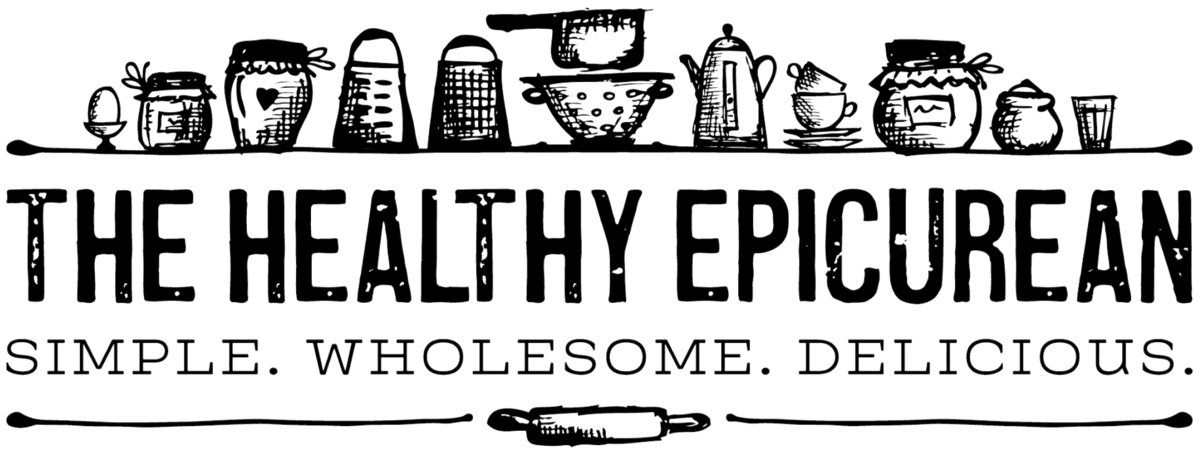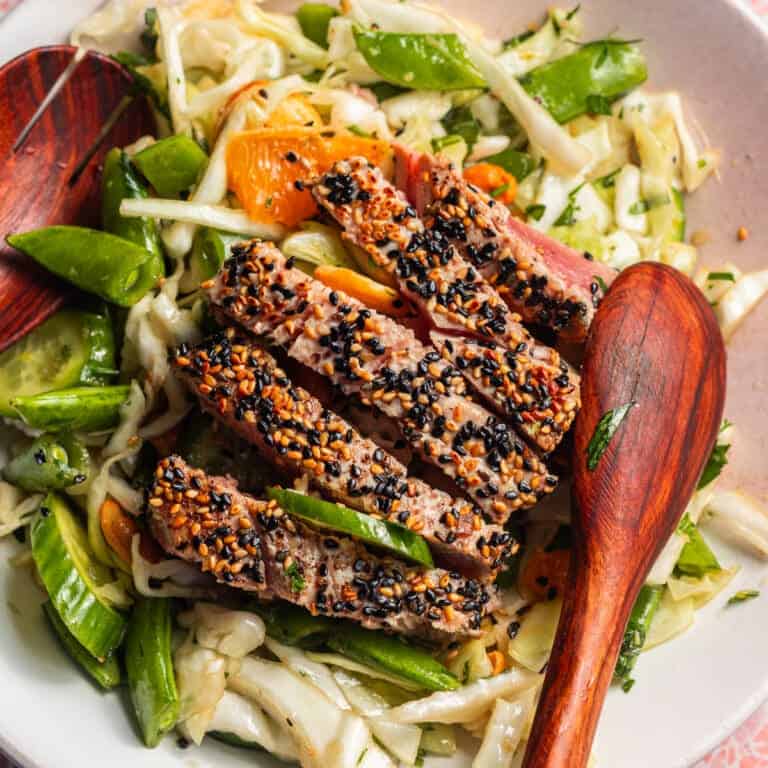60+ High-Protein, High-Fiber Salad Recipes
Discover 60+ healthy salad recipes packed with protein and fiber to keep you full and satisfied.
Each salad recipe includes loads of high-fiber vegetables, greens and/or fruits, high-protein foods like lean meat, seafood, fish, beans, legumes, grains and/or nuts and seeds, and are paired with a tasty dressing to bring it all together.
These salads will keep you fuller, longer, helping you reach your health and macro goals!

What makes a salad a balanced meal?
A balanced salad is one that keeps you full and satisfied for several hours. It should have all components of a balanced meal, such as vegetables/greens, high-fiber carbohydrates, lean protein and heart-healthy fats. This is your basic blueprint.
- Greens and vegetables:
- Greens: Romaine lettuce, mixed greens, spring mix, iceberg lettuce, dark leafy greens (chard, mustard greens, kale, spinach, collards, arugula, watercress, beet greens, bok choy) and the list goes on.
- Vegetables: Cauliflower, green beans, broccoli, summer squash, asparagus, Brussels sprouts, carrot, mushrooms, radishes, peppers, tomatoes, celery, cucumber and the list goes on.
- High-fiber carbohydrates: Fruits, potatoes, winter squash, beans, lentils, legumes, peas, brown rice, quinoa, kamut, wheat berries, barley, farro, bulgur and the list goes on.
- Lean protein: Meat (chicken, turkey, lean beef and pork, etc), fish (tuna, salmon, etc), seafood (shrimp, scallops, crab, etc), tofu, tempeh, eggs, some cheeses and the list goes on.
- Heart-healthy fats: Usually comes in the form of a salad dressing made from olive oil or avocado oil, but could also include nuts, seeds, avocado, olives and omega 3-rich fish, such as salmon (which is also a great source of protein).
Some of these ingredients have both protein and fiber, such as beans, lentils, legumes, whole grains, nuts and seeds.
Now that we’ve covered the basics, let’s get into the recipes. Enjoy!
Salad Recipes with Grains, Beans and/or Legumes
Kale Caesar Salad with Crispy Chickpeas
Dinosaur kale is massaged with the BEST caesar dressing, then tossed with freshly shaved Parmesan, crispy roasted chickpeas and drizzled with more of that amazing caesar salad.
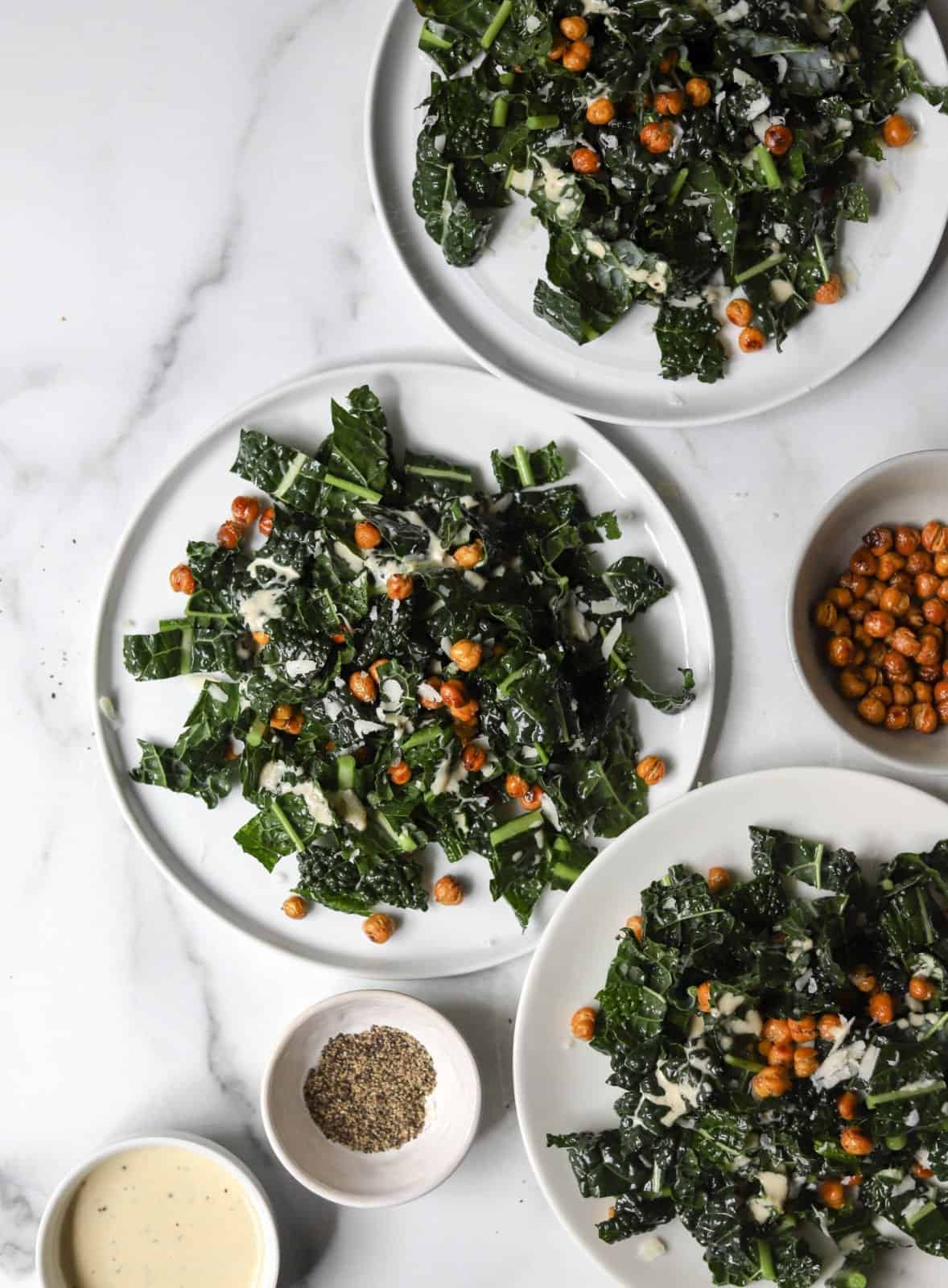
Arugula Quinoa Salad
A healthy, Mexican-inspired salad, this Arugula and Quinoa Salad features luscious mangoes, toasted pepitas, queso fresco, pomegranate arils, and a tangy pomegranate vinaigrette. The quinoa takes about 10 minutes, and you can prep the salad and make the dressing in that time frame.
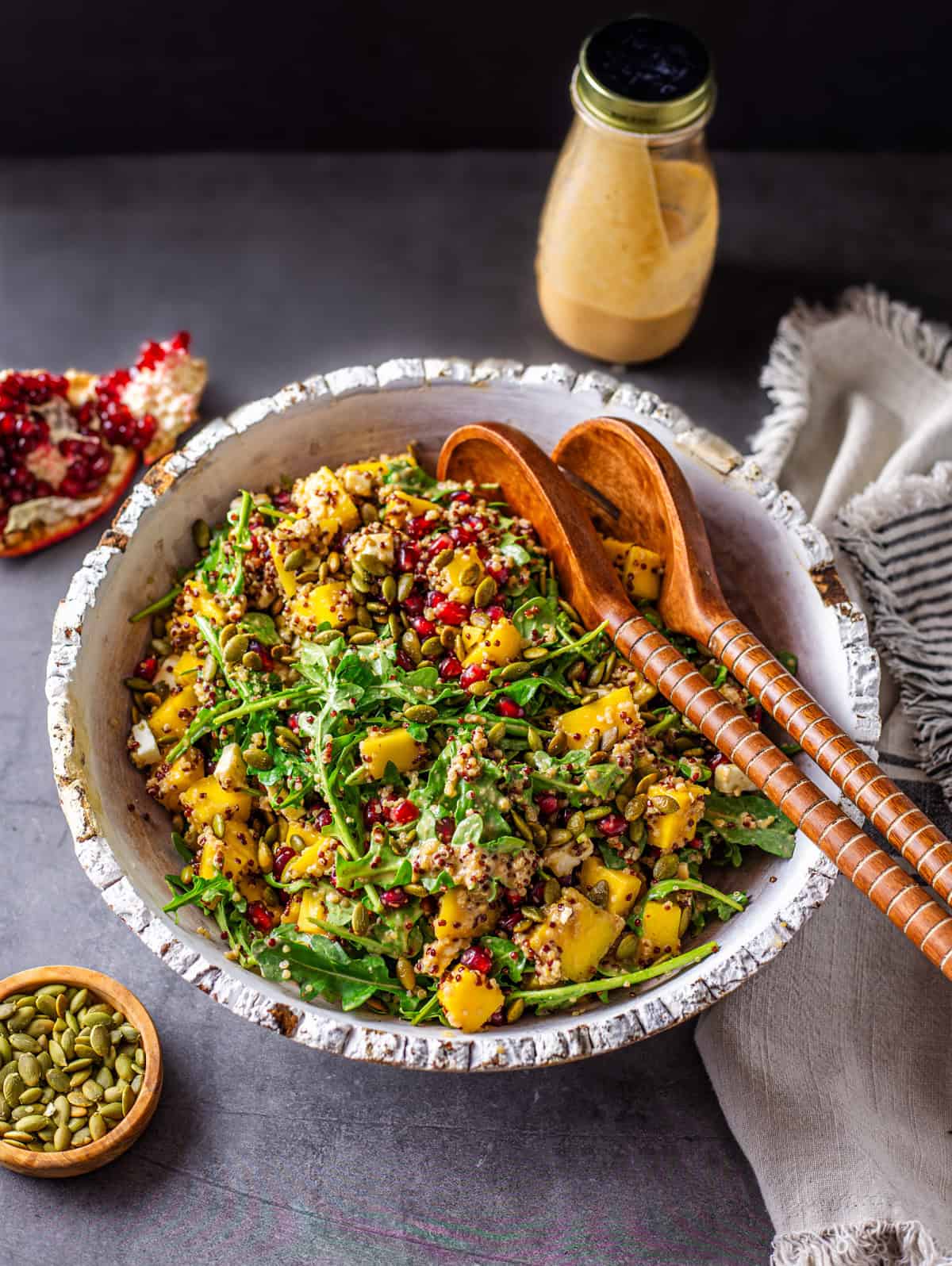
Greek Chickpea Salad
This vegan greek chickpea salad is the perfect way to highlight late summer produce like cucumber, tomatoes, peppers, and herbs. Topped with a light lemon dressing it’s a great light dinner or packed lunch.
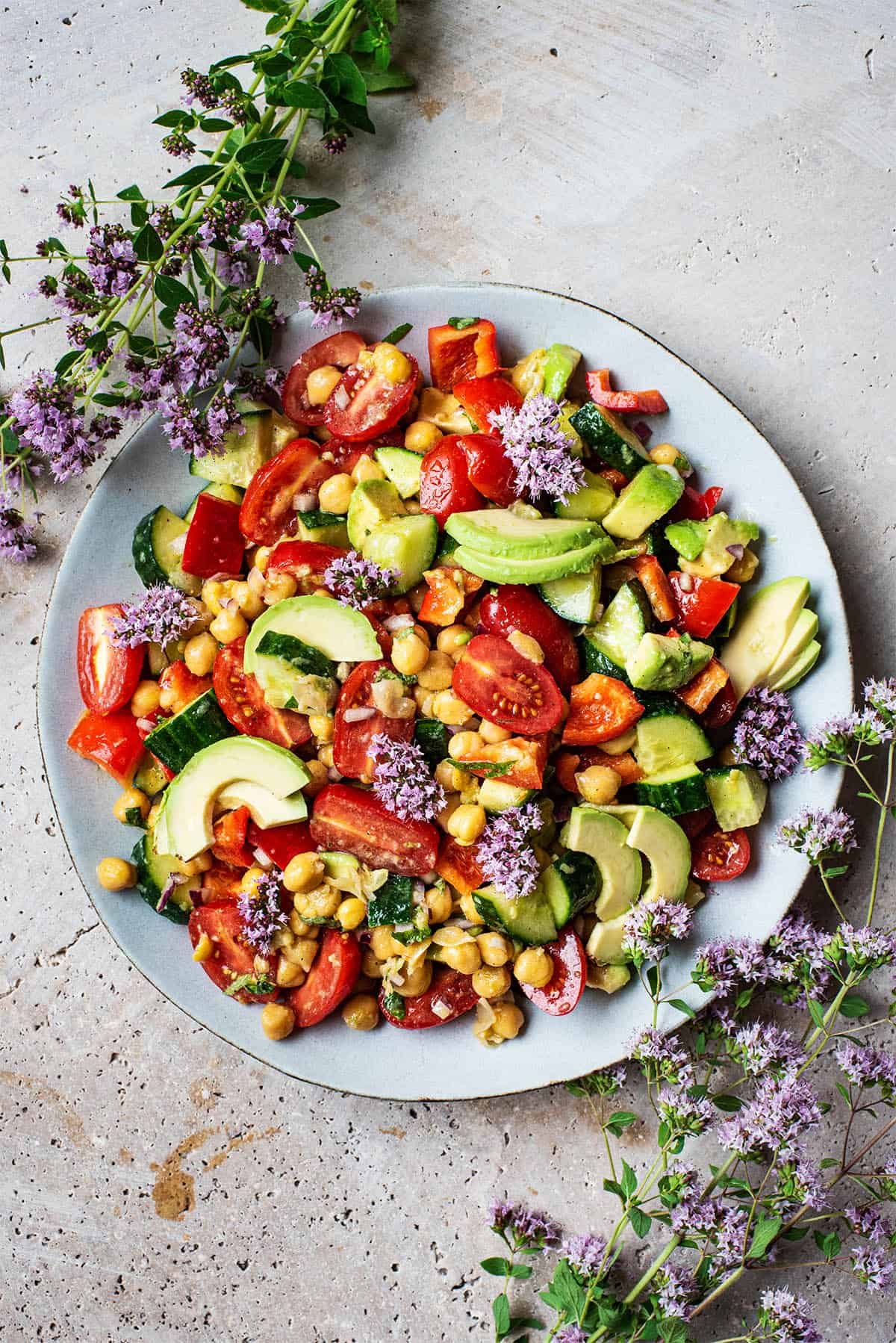
Couscous Salad with Peaches and Lemon Dressing
This quick and easy couscous salad and dressing recipe is fresh, healthy and deliciously addictive. The bright lemon salad dressing is made from only 4 simple ingredients and the peaches add a sweet touch.
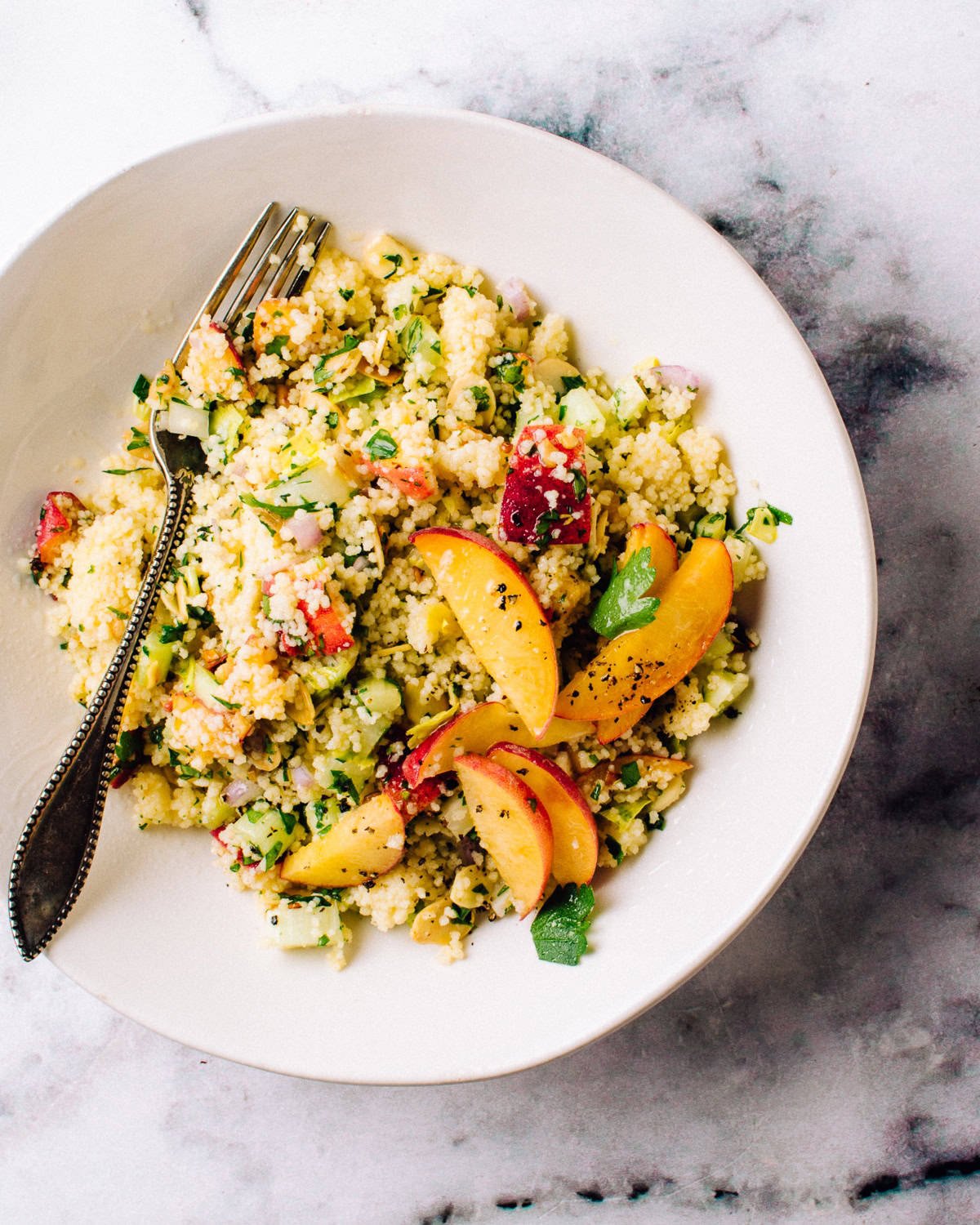
Try these other high-protein, high-fiber salads with beans, legumes and grains
- Butternut Squash Buckwheat Salad
- Moroccan Roasted Vegetable Salad
- Lentil and Kale Salad
- Brown Rice and Quinoa Salad
- Broccoli Lentil Salad with Lemon Tahini Dressing
- Asian Rice Salad
- Lentil Tabbouleh Salad
- Corn Avocado Salad
- Arugula Quinoa Salad
- Chili Lime Quinoa Salad
- Vegan Crispy Rice Salad
- Quinoa and Lentil Salad
- Roasted Chickpea Salad
- Chickpea and Kidney Bean Salad
- Winter Kale Salad
Salad Recipes with Fruit
Cucumber Melon Salad with Mint
A simple, refreshing cucumber melon salad made with the best of summer produce, this is an excellent light dish for summertime.
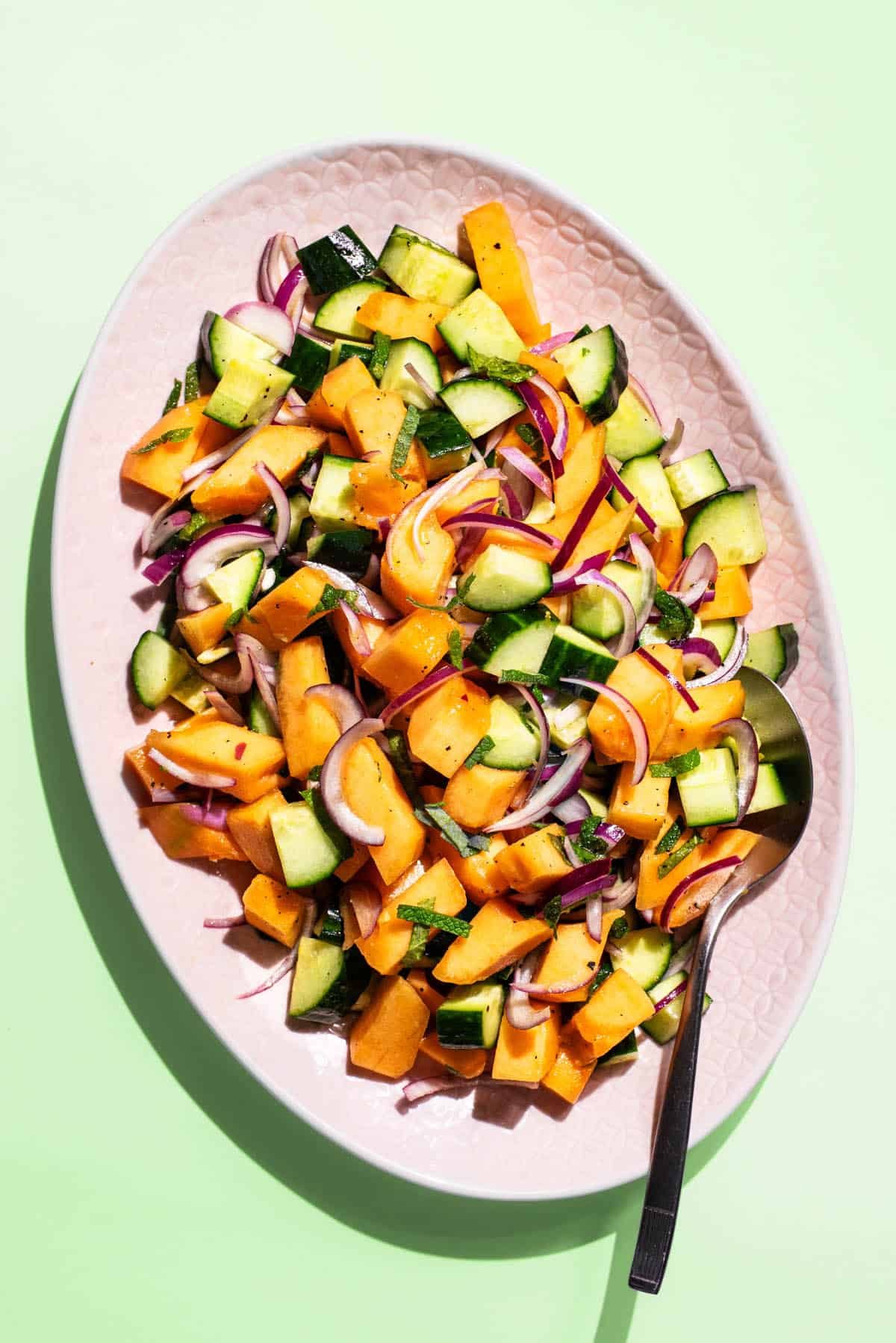
Citrus Arugula Salad with Pomegranate Dressing
This salad is loaded with citrus segments, creamy avocado, toasted walnuts, juicy pomegranate arils and tangy goat cheese. It’s drizzled with pomegranate dressing for the perfect pop of fresh flavors.
Add chicken, salmon or chickpeas to make a balanced, higher protein salad.
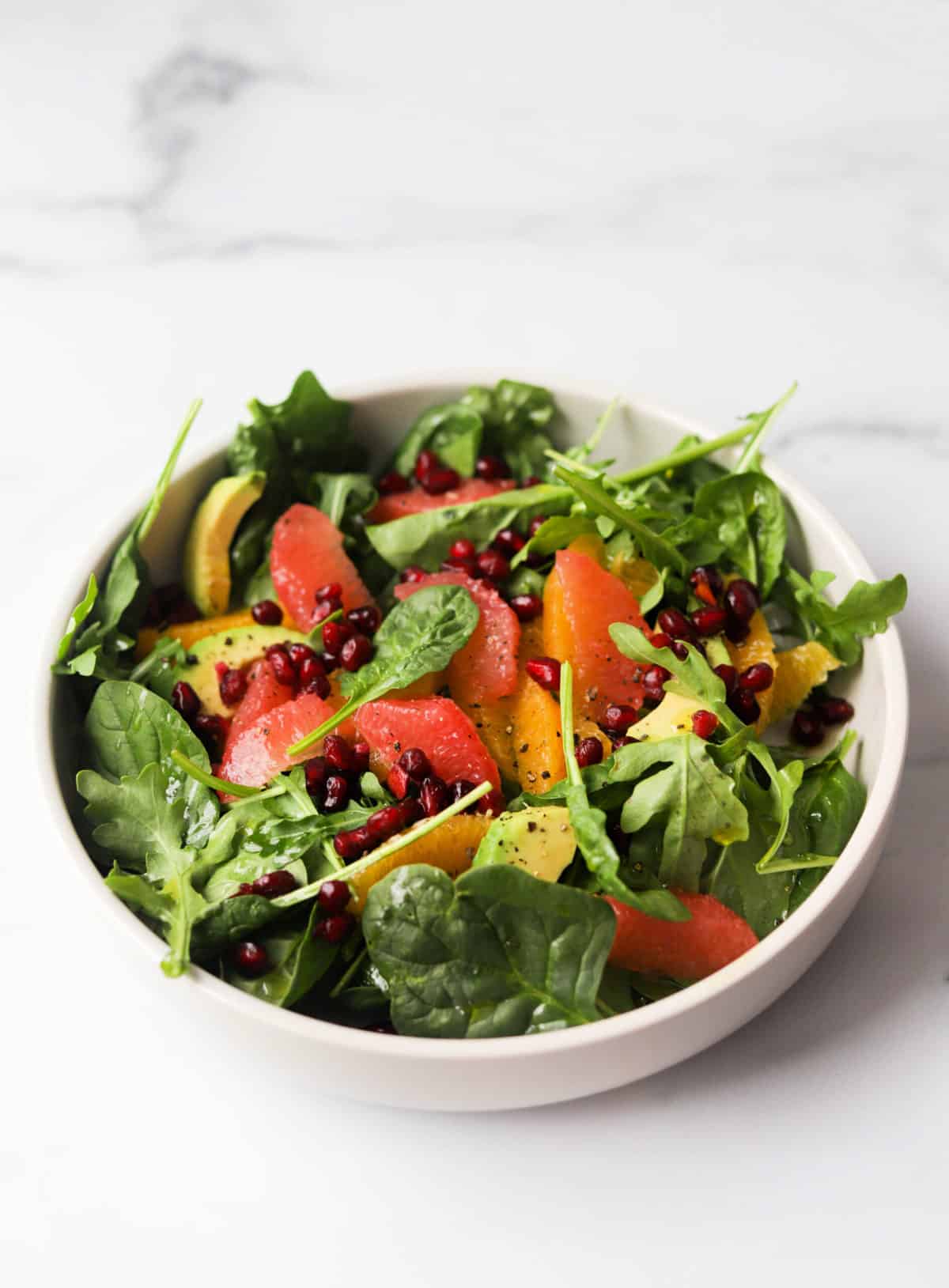
Cold Weather Detox Salad with Crispy Lentils
This vegan orange salad is filled with citrus, pomegranate, and crispy roasted lentils and greens. Topped with an orange ginger vinaigrette.

Try these other high-protein, high-fiber salads with fruit
- Peach Salad with Maple Balsamic Vinaigrette
- Watermelon Salad with Basil
- Almond Strawberry Salad with Fennel
- Summer Cobb Salad
- Strawberry Pecan Salad
- Simple Citrus Salad
- Berry Chicken Salad with Honey Balsamic Dressing
- Plantain Salad with Avocado Cilantro Dressing
- Delicata Squash Apple Salad
- Moroccan-Style Orange Salad with Dates and Pomegranates
Salad Recipes with Lots of Greens
Fried Egg Breakfast Salad
Greens and shaved beets tossed in a bright mustard vinaigrette, topped with a fried egg. Salad for breakfast? Yes, please.
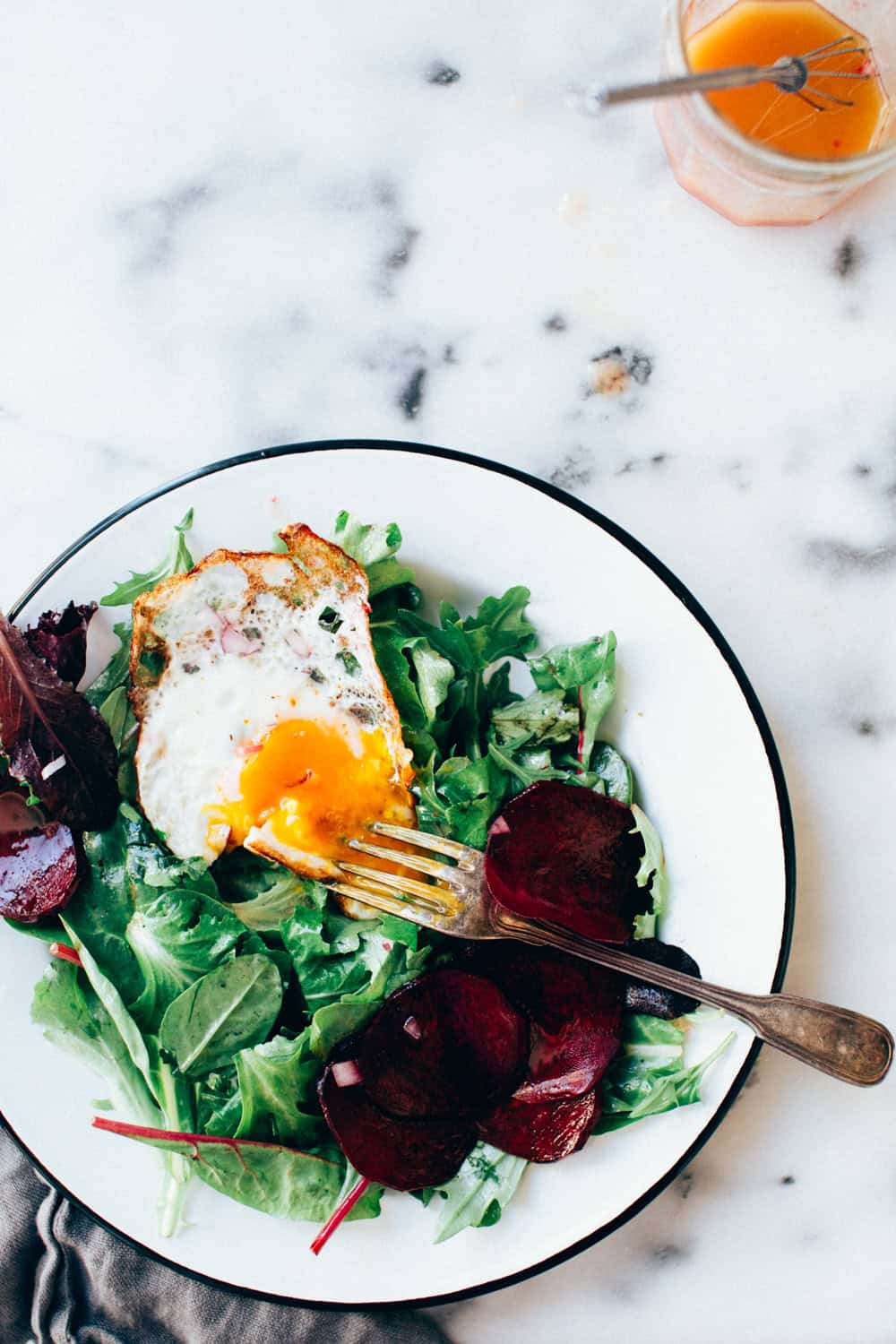
Blackened Chicken Caesar Salad
Blackened Chicken Caesar Salad is a delicious combination of spicy chicken with creamy Caesar dressing and crisp homemade croutons for a delicious and hearty salad. Serve it with some crusty bread for a dinner your whole family will love.
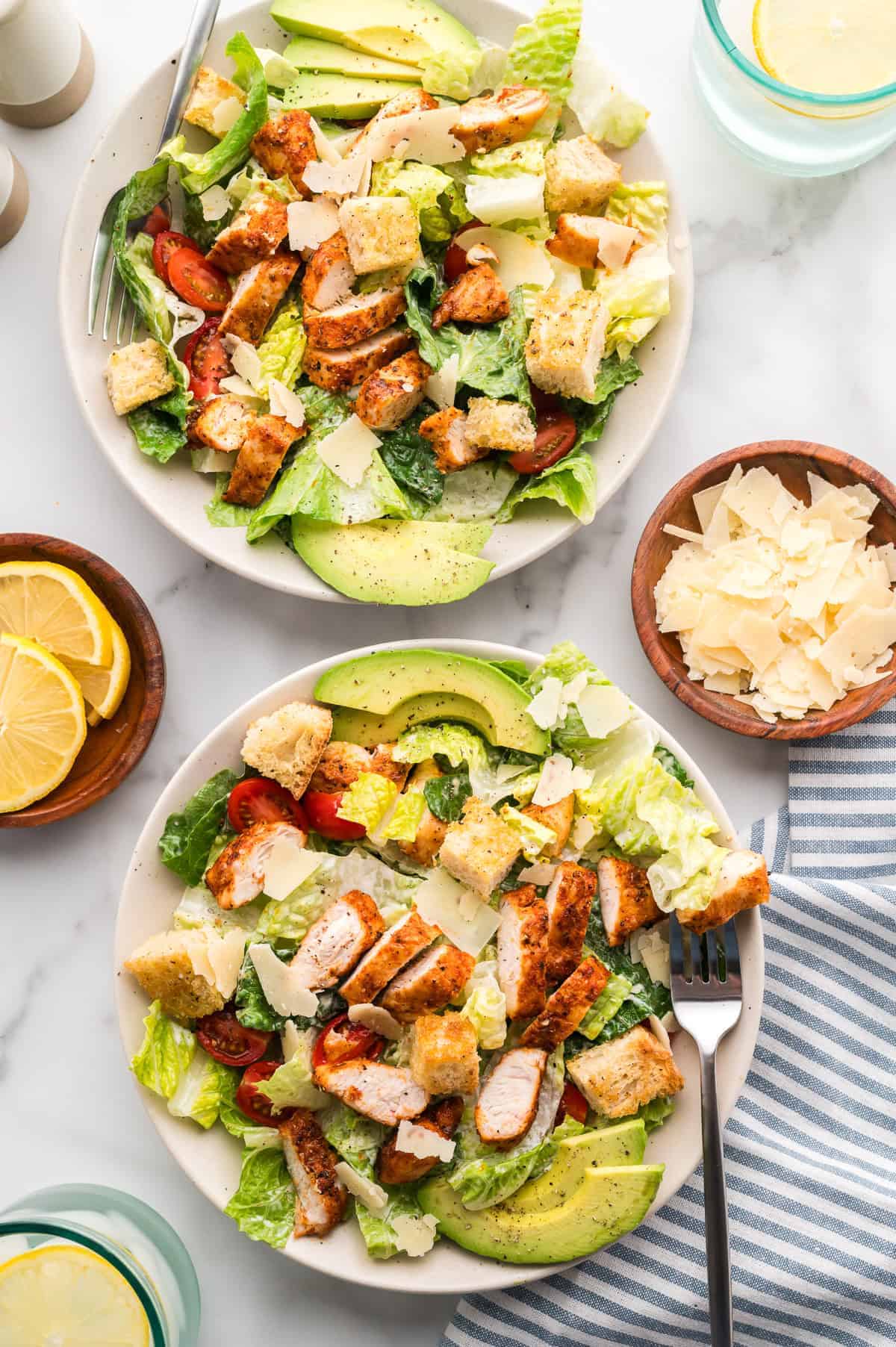
Fattoush Salad
A Middle-Eastern chopped salad with crunchy, fried pita croutons and a quick creamy sauce + why I regularly opt not to eat with my kids.
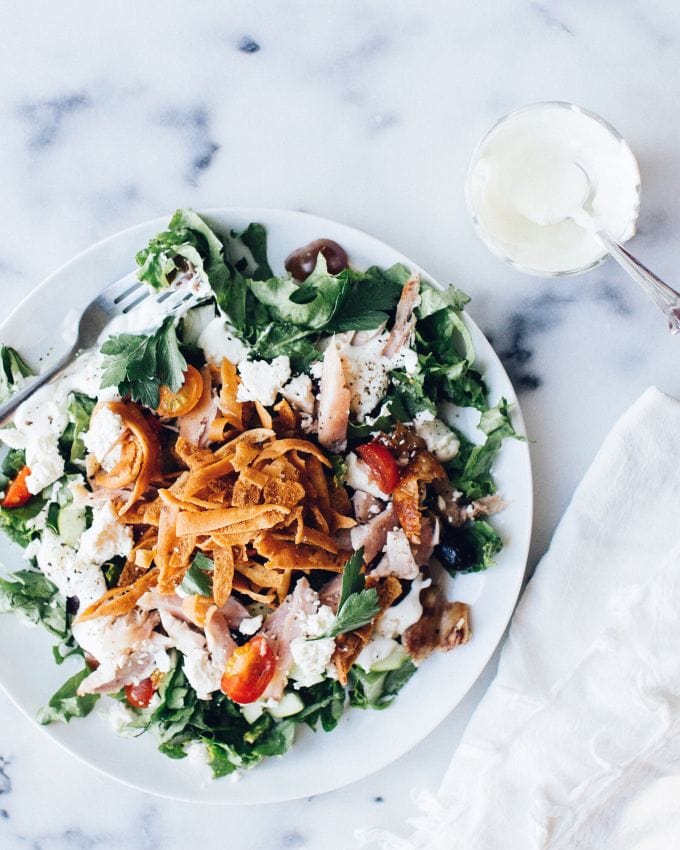
Try these other high-protein, high-fiber salads with loads of greens
- Greek Salad
- Hearty Persian-Style Cucumber Salad
- Southwest Chopped Salad
- Steakhouse Romaine Wedge Salad
- Roasted Brussels Sprouts Salad
Salad Recipes with Meat, Fish or Seafood
Seared Tuna Salad
A fresh salad featuring sesame-crusted tuna, crunchy spring vegetables, and a ginger lime dressing.
Crab Louise Salad
The king of all salad recipes, this one is packed with crisp lettuce, asparagus, cucumber, hard-boiled eggs, avocado, tomatoes, and crab meat and dressed in a flavorful homemade thousand island dressing. It’s a delicious year-round main course salad – especially when Dungeness crab is in season.
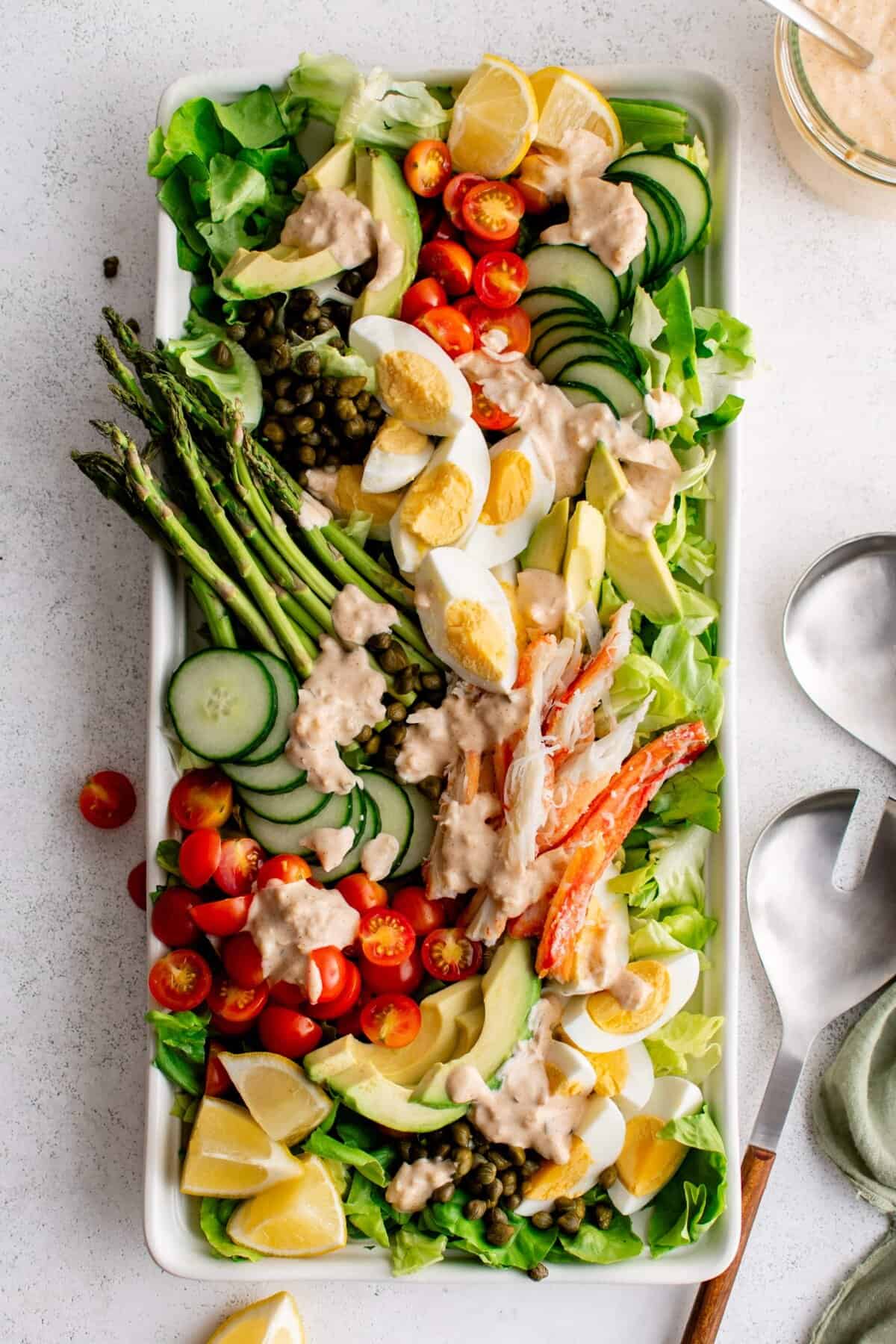
Summer Salad with Chicken
This Summer Salad Recipe is light enough for a hot day, but filling enough that you won’t feel snacky later on.
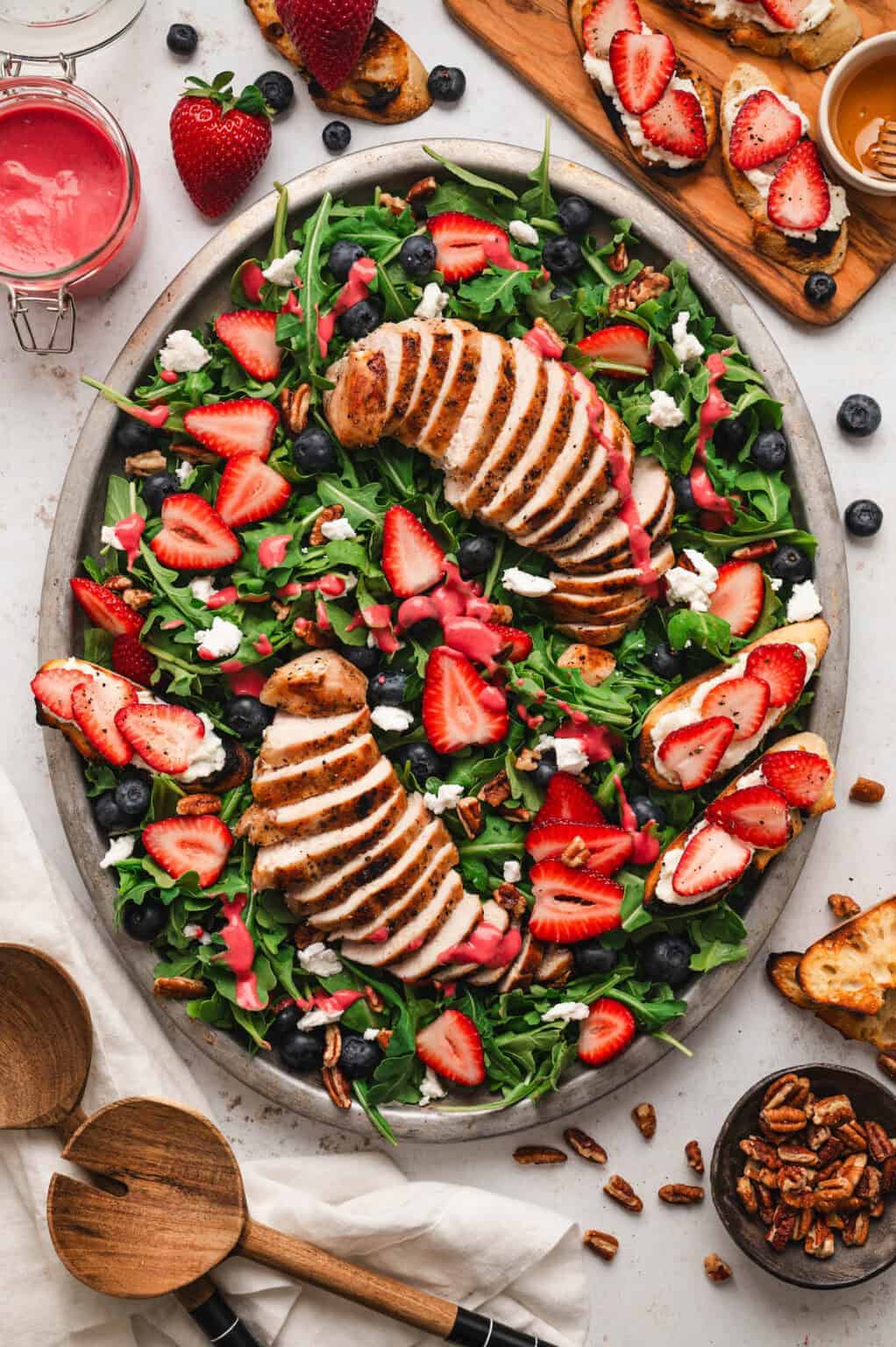
Easy Grilled Steak Salad
Featuring juicy grilled sirloin, peppery arugula, crunchy romaine & cucumbers, sweet tomatoes, creamy avocado, piquant red onion, and tangy blue cheese crumbles all tossed in a homemade basil vinaigrette, this deliciously filling entrée salad is a colorful celebration on a plate.

Lemon Crusted Chicken Salad
If you’re looking for a vibrant, flavor-packed meal that’s fresh, satisfying, and easy to prepare, this bright lemon-crusted chicken with a lemon vinaigrette salad is the perfect choice.

Try these other high-protein, high-fiber salads with meat, fish or seafood
- Cold Duck Noodle Salad
- Seared Tuna Nicoise Salad
- Salmon Kale Salad
- Aromatic Lamb Warm Grain Salad
- Thai Grilled Beef Salad
- Buffalo Chicken Salad
- Steak Salad
- Mexican Tuna Salad
- Salmon Nicoise Salad
- Crunchy Cabbage Salad with Miso Peanut Shrimp
- Salmon Kale Salad
- Seared Scallop with Corn, Avocado and Herb Salad
- Spicy Southwest Salad
- Radicchio Salad with Chicken
- Prawn and Avocado Salad
